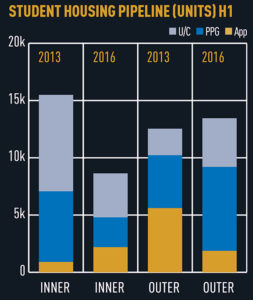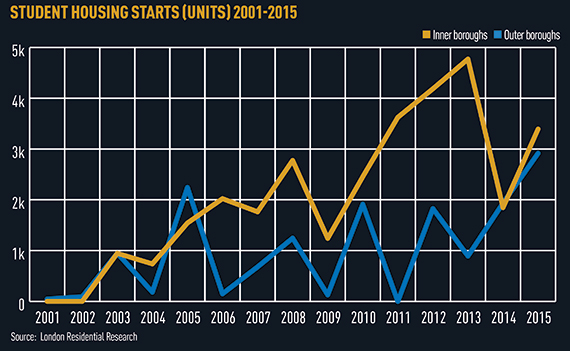
Three years ago we predicted that student housing in the inner boroughs would continue to show strong growth but there would be a push of those units outwards.
It was 2013 and the forecast was bullish. But we believed locating suitable sites would become increasingly problematic, owing to a mixture of both legislative pressure and a shift in developer focus to prime and super-prime residential.
That meant we suspected that future growth would come in the outer boroughs – although little was happening on the ground at the time – as a result of those very pressures that threatened to suppress development in the inner boroughs.
Fast forward and the total number of student housing units under construction in H1 2016 was a shade over 8,000 units. In H1 2013 it was just over 10,700 units. So did we just get it wrong? Not quite. It is not the totals here that are important, it is their composition.
 These figures mask a shift in focus away from the centre to the outer boroughs (see student housing table, right, comparing applications, permissions and developments under construction in 2013 with 2016). Back in 2013, those 10,000 units were split 78% to 22% in favour of inner boroughs. By 2016, the split of the 8,000 units under construction was 53% to 47% in favour of outer boroughs.
These figures mask a shift in focus away from the centre to the outer boroughs (see student housing table, right, comparing applications, permissions and developments under construction in 2013 with 2016). Back in 2013, those 10,000 units were split 78% to 22% in favour of inner boroughs. By 2016, the split of the 8,000 units under construction was 53% to 47% in favour of outer boroughs.
And that move to near construction parity is reflected again in the student housing chart below, which looks at the number of student accommodation unit starts from 2001 to 2015 in both inner and outer boroughs. The lines may be erratic, but the trajectory seems clear.
The past – and to some extent the present – may belong to the inner boroughs, but the future is in the outers.

Nigel Evans is head of EGi’s London Residential Research










